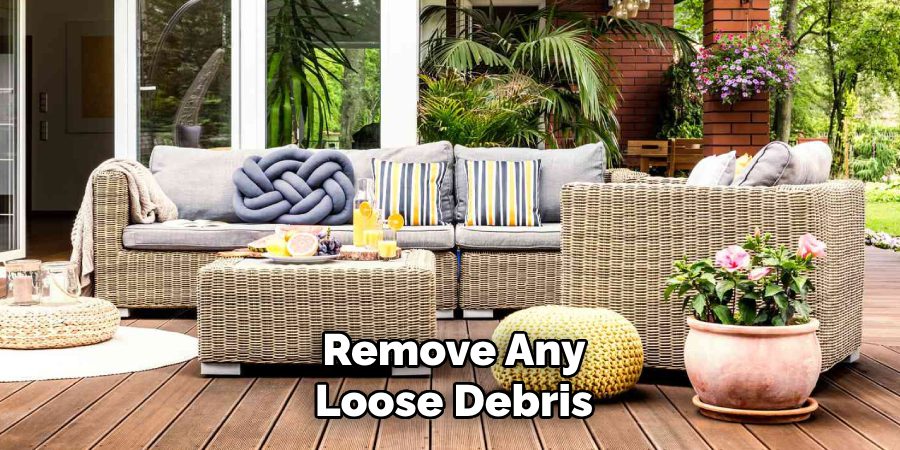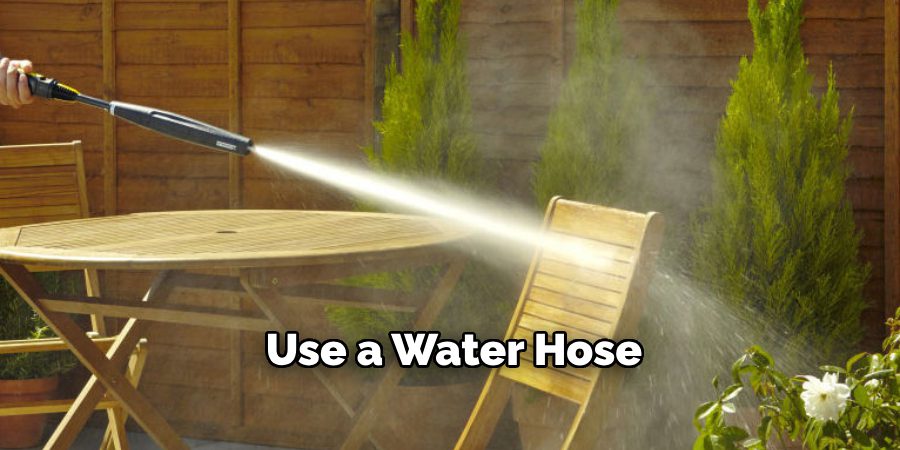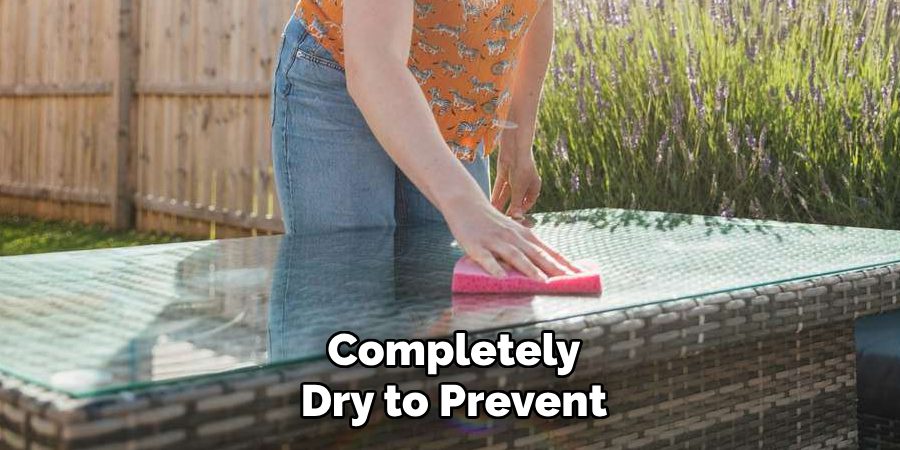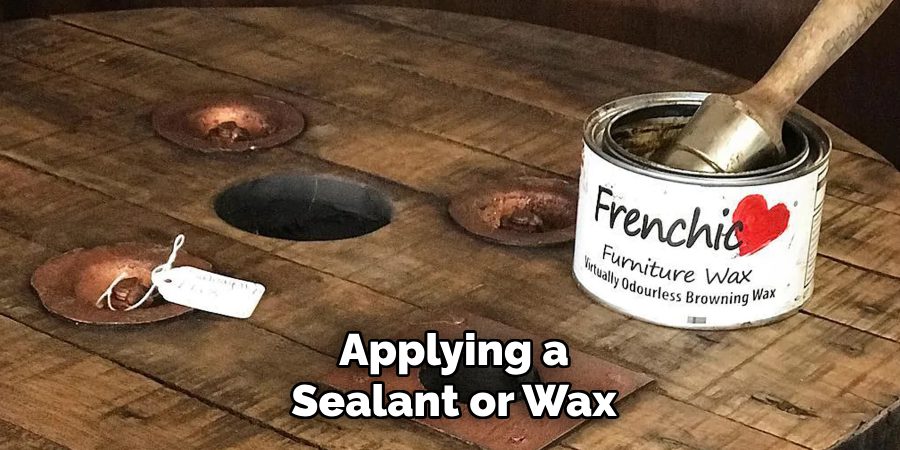Taking care of your patio furniture is essential to ensure its longevity and keep it looking its best. Whether your furniture is made of wood, metal, or wicker, proper maintenance can protect it from the elements and reduce wear and tear over time.

This guide on how to care for patio furniture will provide you with practical tips and techniques to help you clean, protect, and store your outdoor furniture so you can enjoy a comfortable and stylish outdoor space year after year.
Why is Caring for Patio Furniture Important?
Proper care and maintenance of your patio furniture can extend its life span, saving you money in the long run. It also ensures that your outdoor space stays aesthetically pleasing and inviting for you and your guests.
Moreover, regular cleaning and upkeep help prevent damage from exposure to harsh weather conditions such as rain, wind, sun, or snow. In addition, it can prevent mold, mildew, and pests from damaging your furniture.
By following these simple steps for caring for patio furniture, you can maintain its quality and appearance for many outdoor seasons to come.
Needed Materials
- Mild Dish Soap or Specialized Outdoor Furniture Cleaner
- Soft-bristled Brush
- Microfiber Cloth
- Water Hose With Spray Nozzle Attachment
- Waterproof Furniture Covers (Optional)
8 Step-by-step Guidelines on How to Care for Patio Furniture
Step 1: Read the Manufacturer’s Instructions
Before starting any cleaning or maintenance routine, it is crucial to read the manufacturer’s instructions for your patio furniture. These guidelines provide specific recommendations on cleaning methods, materials to avoid, and any special treatments required.
Different furniture materials, such as wood, aluminum, or wicker, may have unique care requirements, and following the instructions can help prevent accidental damage. If you no longer have the physical manual, many manufacturers offer digital copies on their websites. Taking this step ensures that your furniture is cared for appropriately and lasts for years to come.
Step 2: Remove Any Debris or Dirt
Before cleaning your patio furniture, remove any loose debris or dirt that may have accumulated. Use a soft-bristled brush or a dry microfiber cloth to gently brush away leaves, dust, and other particles from the surface and crevices of the furniture.

This step prevents debris from scratching the material during the cleaning process. For stubborn dirt in tight corners, you can use a vacuum cleaner with a narrow attachment. Taking the time to clear away debris ensures a smoother cleaning process and helps maintain the integrity of your furniture.
Step 3: Create a Cleaning Solution
Next, create a cleaning solution by mixing mild dish soap or specialized outdoor furniture cleaner with warm water. Avoid using bleach or harsh chemicals as they can damage the material and cause discoloration.
Use approximately one tablespoon of soap for every gallon of water. If you are dealing with tough stains, you can increase the concentration of soap in the solution but do not exceed two tablespoons per gallon.
Step 4: Clean the Furniture Surface
Dip a soft-bristled brush into the cleaning solution and gently scrub the surface of your patio furniture, paying extra attention to areas with visible stains or dirt buildup. Use light pressure to avoid damaging the material.
For wicker furniture, use a soft-bristled brush and be careful not to snag or loosen any weaving. If you have metal furniture, check for rust spots and gently scrub them with a wire brush dipped in the cleaning solution.
Step 5: Rinse Thoroughly
After cleaning the surface, it is important to rinse your patio furniture thoroughly to remove any soap residue. Use a water hose with a spray nozzle attachment to gently spray down the furniture, ensuring that all soap and loosened dirt are washed away.

For delicate materials like wicker, use a low-pressure spray to prevent damage. For metal furniture, pay close attention to corners and crevices where soap might accumulate. Avoid leaving any residue, as it may cause discoloration or attract more dirt over time. Once rinsed, your furniture will be free of cleaning solution and ready to dry.
Step 6: Dry the Furniture Thoroughly
After rinsing, use a microfiber cloth to wipe down all surfaces of your furniture. If possible, keep the furniture in a sunny area to help it dry faster. This step is important as moisture can cause rust and mold growth on metal furniture and weaken wooden structures.
For wicker or wood furniture, make sure to get into any crevices or tight spaces where water may have pooled during cleaning. Allow the furniture to air dry completely before putting any cushions back on or storing it away.
Step 7: Apply Protection (Optional)
To provide extra protection against weather elements, consider applying a protective layer such as a sealant or wax to your furniture. These products help prevent water damage, fading, and other common issues that can occur with outdoor furniture.
Before applying any protective product, make sure to read the instructions and test it on a small, inconspicuous area first. This step will ensure that the product is compatible with your furniture material and does not cause any unwanted discoloration.
Step 8: Store Your Furniture (Optional)
If you live in an area with harsh weather conditions during certain times of the year, consider storing your patio furniture indoors or under a waterproof cover when not in use. This step protects it from extreme heat, cold, rain, snow, and wind, which can cause faster damage.
When storing your furniture, make sure it is clean and completely dry to prevent any mold or mildew growth. Covering it with a waterproof cover further protects it from water and dirt buildup during storage.

Following these simple guidelines on how to care for patio furniture can help you maintain the quality and appearance of your patio furniture, ensuring its longevity and comfort for many outdoor seasons to come. Remember to always consult the manufacturer’s instructions first and use gentle cleaning methods to avoid damaging your furniture. Enjoy your well-maintained outdoor oasis!
Additional Tips
- For quick cleanups, keep a dry microfiber cloth handy to wipe down the furniture surface and remove any light dust or debris.
- To prevent scratches on metal or wood surfaces, place felt pads under furniture legs before placing them on your patio.
- Regularly check for any signs of damage, such as cracks, rust, or loosened joints, and address them promptly to prevent further issues.
- Avoid leaving your furniture cushions outside for extended periods as they can accumulate mold and mildew. Instead, store them in a dry area when not in use.
- If your patio furniture has cloth or fabric surfaces such as cushions or umbrellas, follow the manufacturer’s instructions for cleaning and maintenance to avoid damaging the material.
Frequently Asked Questions
Q: How Often Should I Clean My Patio Furniture?
A: It is recommended to clean your outdoor furniture at least once a season or more frequently if it is exposed to high levels of dirt or pollution. It is also a good idea to give your furniture a quick wwipe-downafter heavy use or exposure to rain.
Q: Can I Use Pressure Washers on My Patio Furniture?
A: Pressure washers are not recommended for most patio furniture as the high-pressure water can damage delicate surfaces and cause dents or loosened joints. If you must use a pressure washer, make sure to adjust the pressure settings and keep it at least 12 inches away from the furniture surface.
Q: What Should I Do if My Patio Furniture Has Mold or Mildew?
A: If mold or mildew has formed on your patio furniture, clean it with a mixture of equal parts water and white vinegar. Scrub the affected area and rinse thoroughly with water. Allow the furniture to air dry completely before using it again. To prevent mold and mildew growth, make sure to store your furniture in a dry area during wet or humid weather conditions.
Q: How Do I Protect My Patio Furniture from Sun Damage?
A: Exposure to direct sunlight can cause fading and discoloration on some materials such as wood and fabric. To protect your furniture, consider investing in protective covers or applying a sealant or wax that offers UV protection. Additionally, you can move your furniture to a shaded area when not in use.

Q: Can I Use Dish Soap Instead of Mild Detergent for Cleaning Patio Furniture?
A: While dish soap may seem like a gentle option, it can contain harsh chemicals that can damage certain furniture materials. It is best to stick to mild detergents specifically designed for outdoor furniture or use natural cleaning solutions such as vinegar and water. Always test any cleaning product on a small, inconspicuous area first before using it on your entire piece of furniture.
Conclusion
Taking care of your patio furniture may require some time and effort, but the results are well worth it. By regularly cleaning, properly drying, and protecting your furniture, you can extend its lifespan and maintain its beauty for many outdoor seasons to come.
Follow these simple guidelines on how to care for patio furniture and enjoy a well-maintained outdoor space where you can relax and entertain guests without worry. Remember to always refer back to the manufacturer’s instructions for specific care recommendations based on the material of your furniture. Happy cleaning!

Professional Focus
Oliver Wood, a passionate patio designer, specializes in creating comfortable and inviting outdoor spaces that enhance relaxation and entertainment. His work combines a deep understanding of design with a love for nature, making him a standout professional in the field of outdoor living spaces. Through his thoughtful approach, he transforms everyday patios into extraordinary retreats for family and friends.
About the Author
Oliver Wood, a skilled patio designer, shares his expertise on outdoor living through his designs and insights. With a background in patio design and a genuine passion for creating beautiful spaces, he encourages others to invest in their outdoor environments, enhancing their homes with functional and inviting spaces for relaxation and entertainment.
Education History
University: Virginia Union University
Oliver’s education equipped him with the knowledge and skills to design patios that merge aesthetics with comfort, transforming outdoor areas into beautiful extensions of the home.
Expertise:
- Patio Design and Outdoor Living Spaces
- Functional and Aesthetic Landscaping
- Comfortable and Inviting Outdoor Environments
- Design Philosophy for Family-Oriented Spaces
- Creating Spaces for Relaxation and Entertainment
